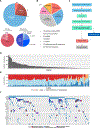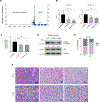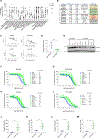Functional analysis of RPS27 mutations and expression in melanoma
- PMID: 31663663
- PMCID: PMC7180098
- DOI: 10.1111/pcmr.12841
Functional analysis of RPS27 mutations and expression in melanoma
Abstract
Next-generation sequencing has enabled genetic and genomic characterization of melanoma to an unprecedent depth. However, the high mutational background plus the limited depth of coverage of whole-genome sequencing performed on cutaneous melanoma samples make the identification of novel driver mutations difficult. We sought to explore the somatic mutation portfolio in exonic and gene regulatory regions in human melanoma samples, for which we performed targeted sequencing of tumors and matched germline DNA samples from 89 melanoma patients, identifying known and novel recurrent mutations. Two recurrent mutations found in the RPS27 promoter associated with decreased RPS27 mRNA levels in vitro. Data mining and IHC analyses revealed a bimodal pattern of RPS27 expression in melanoma, with RPS27-low patients displaying worse prognosis. In vitro characterization of RPS27-high and RPS27-low melanoma cell lines, as well as loss-of-function experiments, demonstrated that high RPS27 status provides increased proliferative and invasive capacities, while low RPS27 confers survival advantage in low attachment and resistance to therapy. Additionally, we demonstrate that 10 other cancer types harbor bimodal RPS27 expression, and in those, similarly to melanoma, RPS27-low expression associates with worse clinical outcomes. RPS27 promoter mutation could thus represent a mechanism of gene expression modulation in melanoma patients, which may have prognostic and predictive implications.
Keywords: RPS27; biomarker; drug resistance; high-throughput sequencing; non-coding; promoter analysis.
© 2019 John Wiley & Sons A/S. Published by John Wiley & Sons Ltd.
Conflict of interest statement
Conflict of interest
The authors declare no conflict of interest.
Figures





Similar articles
-
A highly recurrent RPS27 5'UTR mutation in melanoma.Oncotarget. 2014 May 30;5(10):2912-7. doi: 10.18632/oncotarget.2048. Oncotarget. 2014. PMID: 24913145 Free PMC article.
-
CFTR modulates RPS27 gene expression using chloride anion as signaling effector.Arch Biochem Biophys. 2017 Nov 1;633:103-109. doi: 10.1016/j.abb.2017.09.014. Epub 2017 Sep 21. Arch Biochem Biophys. 2017. PMID: 28941802
-
Neddylation modification of ribosomal protein RPS27L or RPS27 by MDM2 or NEDP1 regulates cancer cell survival.FASEB J. 2020 Oct;34(10):13419-13429. doi: 10.1096/fj.202000530RRR. Epub 2020 Aug 11. FASEB J. 2020. PMID: 32779270
-
Somatic driver mutations in melanoma.Cancer. 2017 Jun 1;123(S11):2104-2117. doi: 10.1002/cncr.30593. Cancer. 2017. PMID: 28543693 Review.
-
The genomic landscape of cutaneous melanoma.Pigment Cell Melanoma Res. 2016 May;29(3):266-83. doi: 10.1111/pcmr.12459. Epub 2016 Mar 4. Pigment Cell Melanoma Res. 2016. PMID: 26833684 Review.
Cited by
-
Defective Human SRP Induces Protein Quality Control and Triggers Stress Response.J Mol Biol. 2022 Nov 30;434(22):167832. doi: 10.1016/j.jmb.2022.167832. Epub 2022 Sep 19. J Mol Biol. 2022. PMID: 36210597 Free PMC article.
-
Overexpressed MPS-1 contributes to endometrioma development through the NF-κB signaling pathway.Reprod Biol Endocrinol. 2021 Jul 15;19(1):111. doi: 10.1186/s12958-021-00796-z. Reprod Biol Endocrinol. 2021. PMID: 34266426 Free PMC article.
-
Quantitative Proteomic Analysis of Plasma Exosomes to Identify the Candidate Biomarker of Imatinib Resistance in Chronic Myeloid Leukemia Patients.Front Oncol. 2021 Dec 21;11:779567. doi: 10.3389/fonc.2021.779567. eCollection 2021. Front Oncol. 2021. PMID: 34993140 Free PMC article.
-
An integrated approach to identify bimodal genes associated with prognosis in câncer.Genet Mol Biol. 2021 Oct 4;44(3):e20210109. doi: 10.1590/1678-4685-GMB-2021-0109. eCollection 2021. Genet Mol Biol. 2021. PMID: 34617951 Free PMC article.
-
Functional analysis of recurrent CDC20 promoter variants in human melanoma.Commun Biol. 2023 Nov 29;6(1):1216. doi: 10.1038/s42003-023-05526-2. Commun Biol. 2023. PMID: 38030698 Free PMC article.
References
Publication types
MeSH terms
Substances
Grants and funding
- NIH/NCI 5 T32 CA009161-37/CA/NCI NIH HHS/United States
- T32 CA009161/CA/NCI NIH HHS/United States
- R01CA2022027/CA/NCI NIH HHS/United States
- R01 CA202027/CA/NCI NIH HHS/United States
- P50 CA225450/CA/NCI NIH HHS/United States
- P01 CA206980/CA/NCI NIH HHS/United States
- NIH S10 Grant S10 OD021747/NH/NIH HHS/United States
- S10 OD021747/OD/NIH HHS/United States
- P01CA206980/CA/NCI NIH HHS/United States
- Melanoma SPORE P50CA225450/CA/NCI NIH HHS/United States
- P30 CA016087/CA/NCI NIH HHS/United States
- NIH/NCI P30CA016087/CA/NCI NIH HHS/United States
LinkOut - more resources
Full Text Sources
Medical

